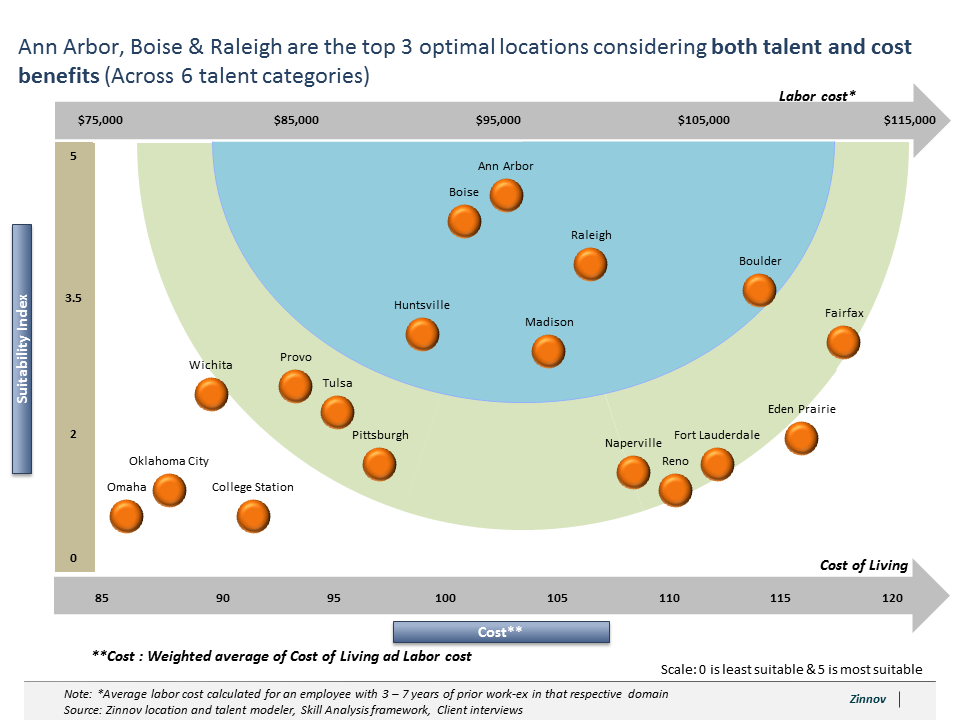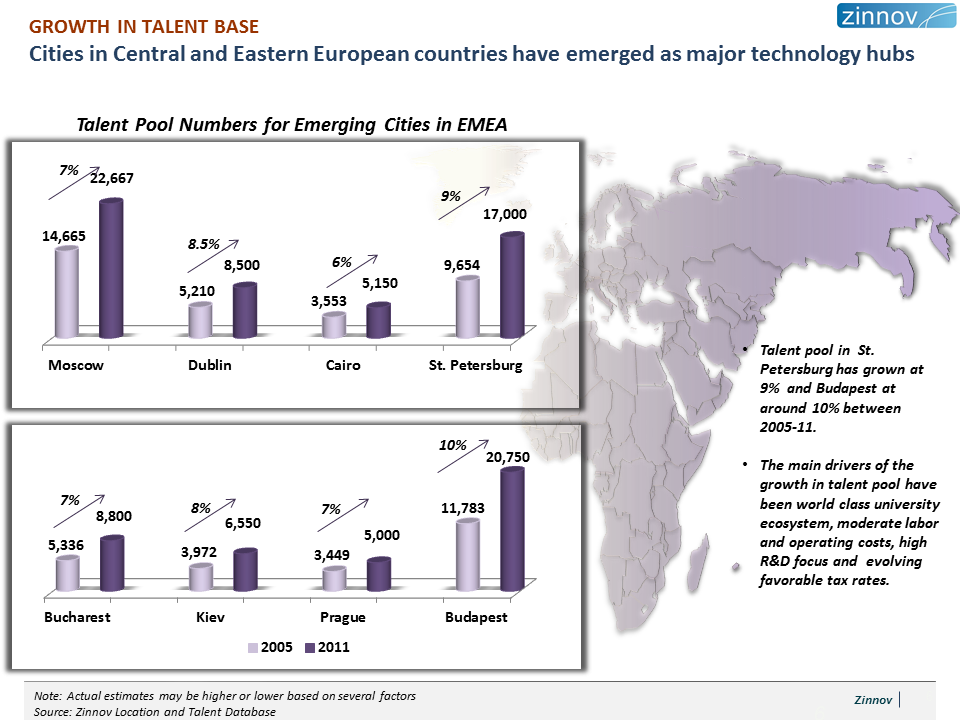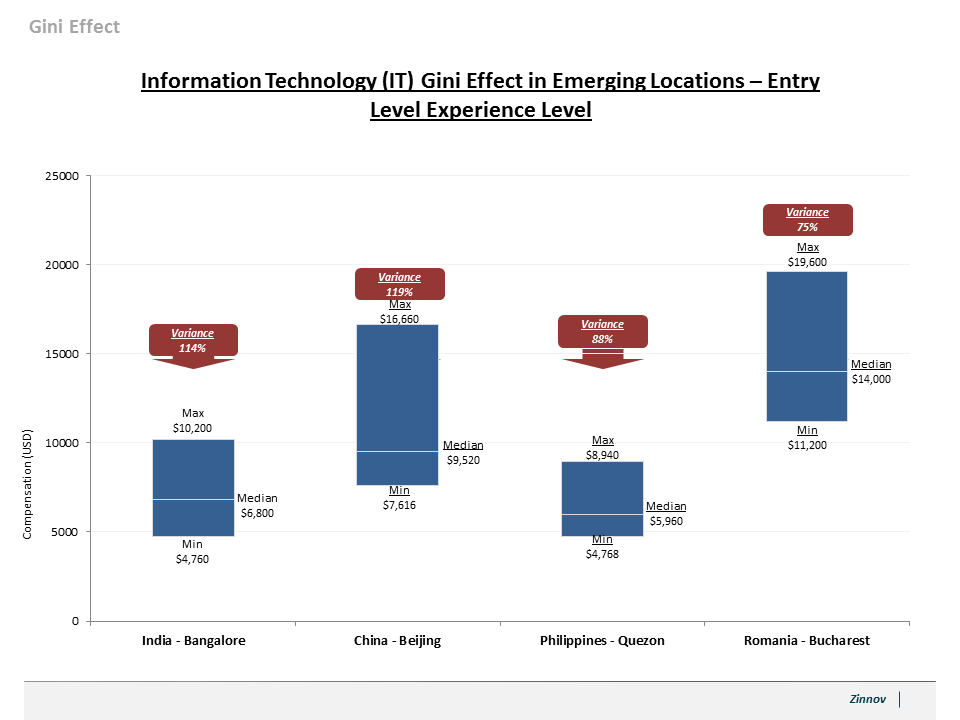From Gini Effect to Goldilocks Syndrome in the Global Technology Pool
2012 will see an increase in the global location and talent footprint of technology companies. The global foot print of technology companies is influenced by many drivers. In a recent Zinnov survey of HR leaders, the following reasons were identified as the primary drivers:
- Planned movement to global locations to take advantage of superior global design and development skills
- Planned movement to global locations with cost savings as the primary goal
- Global location growth due to acquisitions
- Movements associated with market expansion
The primary objective of this article is to explore the cost characteristics of the global technology talent. Several economic factors dominated the year 2011 including reduced consumer spending in the U.S., the European debt crisis, and economic policy issues in Asia. The economic factors have medium to long-term impact on the cost and availability of the global talent pool.
In addition to explaining cost characteristics of the global technology talent, this article will also examine the relationship between the talent pool and macro-economic factors.
Rise of the “Gini effect” in emerging locations
In emerging countries, there is significant variation in cost for a similar talent classification at the same location, for the same position. This wide range of pay introduces the classical economic “Gini effect” wherein locations like India and China have a wide range of pay for a specific experience level in a given domain.
For example, the compensation for entry-level IT professionals in Bangalore, India is in the range of USD 4,760 – USD 10,200. A similar trend exists in software and hardware product development domains. In other words, if examined using classical economic models, the Gini index will be high for various job levels and positions in emerging countries. Zinnov recently analyzed why this variation is more pronounced in emerging countries. The three major factors contributing to this effect are as follows:
- Type of employer: In emerging countries, there is a distinct pay difference between what multinational companies (MNC) companies, service provider companies and the local companies pay their respective talent.
- Type of education: The fresh engineering talent pool (which feeds a majority of the talent pool) can originate from different grades of engineering institutes (commonly referred to as the Tier 1, Tier 2 and Tier 3 institutes).
- Alternate talent pool: In addition to the core engineering curriculum, several non-engineering graduates undergo training in the form of certifications and enter the technology talent pool.
The Gini effect is not necessarily a new trend in emerging locations. And it is bound to continue as there is the prolific expansion of institutes, the emergence of tier-2 cities at these locations and as more and more non-engineering graduates aspire to enter into the technology industry through certifications. Such disparities normally take years to dissipate; hence the Gini effect will continue for the next few years. Companies need to understand this effect for the following reasons:
- This situation provides a unique opportunity to global organizations – a realignment of the pyramid structures with respect to the type of work executed at these locations can greatly improve the contribution as well as impact of emerging locations in the location matrix.
- The business case of executing a global portfolio may look more aggressive on paper than in reality. This is because the benchmarks may indicate a lower average due to this disparity during planning stages.
In summary, the Gini effect can be an advantage if understood thoroughly by organizations.
Salary growth rates and Goldilocks syndrome
In Asia Pac countries, there is on an average, an increase of about 8-12 percent per year in the labor cost across various levels. Engineering labor cost in emerging locations is also the domain with the highest pay. Zinnov’s recent analysis of labor cost across four key domains – BPO, IT, technology and manufacturing – revealed some interesting insights.
As a general rule, salary increases with experience across the four domains but the rate of pay growth by experience levels is highest in technology. In the technology domain in emerging locations, based on our data set, a minimum salary of around USD 10,000 and a maximum salary of around USD 160,000 were observed. Other verticals proved less expensive with a minimum salary of less than USD 5,000 and a maximum salary of USD 85,000 to USD 100,000 for the BPO, manufacturing and IT domains.
The consistent growth in salary in India and China has induced a “Goldilocks syndrome” effect in the labor pool. A classic situation of this effect is when the labor pool almost expects constant and upward growth in the pay rate. This effect is very complex when analyzed from a behavior science point of view. The expectation is set by several aspects including social, environmental and employee peer factors.
Zinnov’s analysis also shows that the top of the pyramid “management” talent pool may have limited mobility options. This is because there are only a few positions that would offer similar pay advantages at that level.
In countries like India, the inflation rate is increasing at very high levels. In spite of such not-so-favorable labor cost headwinds, the Asia Pac locations will continue their dominance in technology talent and location footprint.
 Figure 2: Labor Cost Growth Rates
Figure 2: Labor Cost Growth Rates
The primary reasons for this expected trend include:
- The median cost of the technology talent pool is still the lowest in the Asia Pac region, making these locations very attractive, especially for large technology teams.
- Innovation, a key metric indicating the maturity of the talent pool, is on the rise in Asia. Several examples and case studies are emerging from India and China in the field of technological innovation.
- Since 2005, Asian countries have seen maximum growth rate in the talent pool number; India and China are leading the pack.
- Favorable government policies, especially in China, have accelerated growth of the technology talent pool.
- The customer base for technology companies in the Asia Pac region is expanding constantly resulting in “close to customer” talent requirements
Second talent wave: the emergence of tier-2 locations in the United States
In 2011, Zinnov launched an extensive analysis of tier-2 locations in the United States with an objective of evaluating the technology talent pool. Over 50 tier-2 locations were analyzed. The results of our evaluation indicated that some of the locations including Ann Arbor, Boise, Raleigh, Boulder and Fairfax are viable technology locations within the US. Several factors were considered in this evaluation including talent base, university ecosystem, competitive landscape, labor policy and other such critical factors.
Our research and surveys indicated that on an average there is a 30 percent cost difference in the cost for technology talent between tier-1 cities and tier-2 cities. (Please note that our tier definitions were based on talent taxonomy. Locations such as Bay Area and Boston are clustered as tier-1 cities in this analysis while other cities such as Ann Arbor and Boise are clustered as tier 2.)
Based on our analysis, we project that the current economic trends in the U.S. will help these tier-2 locations to continue to gain momentum from this “second talent wave.” These conditions include a moderate recovery in the U.S., slightly better economic conditions compared to 2008, controlled inflation and a slightly improving economic outlook.
Zinnov refers to this wave as a second talent wave because the first talent wave was associated with the movement of talent from the Bay Area to locations like Austin in 2005 to 2006. The first wave brought some initial benefits to Austin; but as the economy collapsed, the global movement took place at a far more aggressive pace.
Zinnov believes that in 2012 more technology companies will take advantage of tier-2 locations in the U.S., especially for small to medium-sized operations.
 Figure 3: U.S. Tier-2 Location Suitability
Figure 3: U.S. Tier-2 Location Suitability
The impact of the European debt crisis
The last few years witnessed growth in several Central and Eastern European locations with respect to the technology talent pool. The situation is not very encouraging when it comes to western European locations. The debt crisis and prolonged unemployment in western European nations is expected to drive out talent to outside locations. Continued economic distress is driving skilled professionals from Europe, and many are moving to former European colonies in Latin America and Africa (Wall Street Journal).
This labor movement will be closely watched in 2012. Several European nations are losing their S&P credit rating; this will further accelerate this movement. Such accelerated movements may further prolong the crisis from a macro economic standpoint.
 Figure 4: Talent Pool Growth in Eastern and Central European Locations
Figure 4: Talent Pool Growth in Eastern and Central European Locations
Conclusion
Prior to 2000, the majority of technology companies were concentrated in one part of the globe, i.e., the U.S. and Western Europe. In the period post 2000, there was the emergence of new global hotspots and a shift of operations to Asia Pac and Eastern and Central European regions.
The technology talent pool in the Asia Pac locations continues to offer several advantages with respect to cost and scale. With those advantages, there are some challenges associated with cost escalation and talent expectation management. A phenomenon called “fat-tailed effect” can be observed with respect to technology talent in Asia-Pac locations. A fat-tailed effect simply states that “averages” will not necessarily indicate the correct market conditions. In such cases, benchmarks around the mean (benchmarks driven by assuming normal distribution of salaries, talent acquisition time, retention period, talent mobility, etc.) may not reflect the ground reality accurately.
While Eastern European technology locations are expected to grow, the world is watching the developments in Western Europe. It will be interesting to see the impact of the crisis on technology talent pool movements in 2012.
Vijay Swami leads the talent practice at Zinnov, a research and consulting firm. He specializes in assisting HR leaders institutionalize data-driven location and talent decisions. Vijay focusses on several aspects of global talent including salary distribution, long-term labor rate trends, global attrition trends, peer company ecosystem and other such influencing factors.

